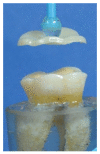Fracture Resistance and Failure Mode of Mandibular Molar Restored by Occlusal Veneer: Effect of Material Type and Dental Bonding Surface
- PMID: 34772003
- PMCID: PMC8585144
- DOI: 10.3390/ma14216476
Fracture Resistance and Failure Mode of Mandibular Molar Restored by Occlusal Veneer: Effect of Material Type and Dental Bonding Surface
Abstract
This study assesses the effect of the material type (lithium disilicate, zirconia, and polymer-infiltrated ceramic) and dental bonding substrates (dentin, dentin with intra-coronal cavity, and dentin with composite filling) on the fracture resistance and failure mode of molars restored by occlusal veneers.
Methods: Ninety occlusal veneers, fabricated from either lithium disilicate, zirconia, or polymer-infiltrated ceramic, were adhesively bonded to teeth prepared with either dentin, dentin with intra-coronal cavity, or dentin with composite filling. All specimens were thermally aged (5000 cycles), then load cycled (120,000 cycles). Each specimen was subjected to a compressive load through fracture, then was examined (×20) to identify the fracture type. Data were statistically analyzed.
Results: Material type and dental substrate had no significant effect on the fracture resistance of adhesively retained occlusal veneer restorations. For each material, no significant differences were found between veneers bonded to dentin, dentin with intra-coronal cavity, and dentin with composite filling. Additionally, within each bonding substrate, there were no significant differences between lithium disilicate, zirconia, and polymer-infiltrated ceramic veneers. The adhesive failure was recorded mainly with zirconia occlusal veneer restorations.
Conclusions: Considering the fracture results, lithium disilicate, zirconia, and polymer-infiltrated ceramic occlusal veneers perform well whatever the type of dental bonding surface. When the dental bonding surface varies, different occlusal veneer materials should be considered. Occlusal veneers bonded to dentin, dentin with composite filling, or dentin with an intra-coronal cavity exhibited a fracture resistance exceeding the average human masticatory forces in the molar area.
Keywords: bonded restoration; non-retentive; resin cement; table-top; tooth wear.
Conflict of interest statement
The authors declare no conflict of interest.
Figures




Similar articles
-
Effect of different ceramic materials and dentin sealing on occlusal veneers bond strength and fracture resistance.BMC Oral Health. 2025 Feb 5;25(1):186. doi: 10.1186/s12903-025-05505-5. BMC Oral Health. 2025. PMID: 39905379 Free PMC article.
-
Influence of restoration thickness and dental bonding surface on the fracture resistance of full-coverage occlusal veneers made from lithium disilicate ceramic.Dent Mater. 2015 Aug;31(8):907-15. doi: 10.1016/j.dental.2015.04.017. Epub 2015 Jun 4. Dent Mater. 2015. PMID: 26051232
-
Effect of immediate dentin sealing on load-bearing capacity under accelerated fatigue of thin occlusal veneers made of CAD-CAM glass-ceramic and resin composite material.Dent Mater. 2023 Apr;39(4):372-382. doi: 10.1016/j.dental.2023.03.003. Epub 2023 Mar 13. Dent Mater. 2023. PMID: 36922258 Clinical Trial.
-
Clinical Survival Rate and Laboratory Failure of Dental Veneers: A Narrative Literature Review.J Funct Biomater. 2024 May 16;15(5):131. doi: 10.3390/jfb15050131. J Funct Biomater. 2024. PMID: 38786642 Free PMC article. Review.
-
Anterior Veneer Restorations - An Evidence-based Minimal-Intervention Perspective.J Adhes Dent. 2021 Apr 7;23(2):91-110. doi: 10.3290/j.jad.b1079529. J Adhes Dent. 2021. PMID: 33825424 Review.
Cited by
-
Effect of preparation design on marginal adaptation and fracture strength of ceramic occlusal veneers: A systematic review.Clin Exp Dent Res. 2022 Dec;8(6):1391-1403. doi: 10.1002/cre2.653. Epub 2022 Sep 5. Clin Exp Dent Res. 2022. PMID: 36062841 Free PMC article.
-
Effect of different ceramic materials and dentin sealing on occlusal veneers bond strength and fracture resistance.BMC Oral Health. 2025 Feb 5;25(1):186. doi: 10.1186/s12903-025-05505-5. BMC Oral Health. 2025. PMID: 39905379 Free PMC article.
-
Elasto-Static Analysis of Composite Restorations in a Molar Tooth: A Meshless Approach.Polymers (Basel). 2024 Feb 7;16(4):458. doi: 10.3390/polym16040458. Polymers (Basel). 2024. PMID: 38399836 Free PMC article.
-
Thickness and Substrate Effect on the Mechanical Behaviour of Direct Occlusal Veneers.Int Dent J. 2023 Oct;73(5):612-619. doi: 10.1016/j.identj.2022.11.006. Epub 2022 Dec 9. Int Dent J. 2023. PMID: 36509557 Free PMC article.
-
Fracture strength of direct occlusal veneers with different short fiber-reinforced composite cores and veneering materials: an in-vitro study.Clin Oral Investig. 2024 Nov 11;28(12):635. doi: 10.1007/s00784-024-06013-6. Clin Oral Investig. 2024. PMID: 39523240 Free PMC article.
References
-
- Vailati F., Belser U.C. Full-mouth adhesive rehabilitation of a severely eroded dentition: The three-step technique. Part 1. Eur. J. Esthet. Dent. 2008;3:30–44. - PubMed
LinkOut - more resources
Full Text Sources

